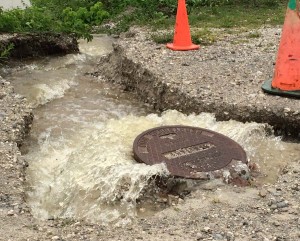Coleridge’s mariner was damned for needlessly shooting an albatross. Toledo however, is bringing on its own destruction by inaction, despite warnings months ago from the Federal EPA. In the small hours of the night, ten days ago, an automated emergency phone call woke us to tell us not to drink the tap water. The annual algae bloom in Lake Erie this year had become too strong, right at the water intake pipe for Toledo’s (and Perrysburg’s) municipal water systems. This satellite view shows the western end of Lake Erie seriously compromised. Toledo and the Maumee river are at the bottom left corner:

For three days we were forbidden to drink the water, wash dishes (unless rinsed in afterwards in ‘clean’ water) or even to spray municipal water on leafy vegetables in the gardens.
The algae is an interesting bright green living slime. Its growth in the lake is accelerated by summer warmth and the excess nutrients (Nitrogen and Phosphorus) from fertilizer runoff from farms and riverside gardens. Heavy rainstorms can also overflow the waste water pipe system, dumping untreated sewage into rivers and lakes which add food to the algae.
The algae produces a harmful non-living, long lasting, stable toxin called microcystin. It cannot be destroyed by boiling and is too small to physically filter out, other than by Carbon filter absorption. It is odorless, colorless and tasteless, but is harmful because it accumulates in one’s liver, according to the World Health Organization (WHO) (it sounds incredible enough to be a story from the famous BBC TV sci-fi Doctor of the same name) in concentrations greater than 1 ppb (part per billion).
Microcystin is incredibly old. It evolved, with cyanobacterial algae blooms about 3 billion years ago, perhaps as a protective agent for the algae, but protecting against what we do not know – back then there were no animals in existence to eat the algae. The toxin might have been protecting it from solar UV according to today’s (2014/8/12) NYT Science section. The blooms themselves were vital to us then as they were the early creators of Earth’s Oxygen.
Our numerically challenged news reporters erroneously had it measured as “1 or 2 ppm” (parts per million) instead of ppb (parts per billion) for a while. But, understandably, it is hard to appreciate that a substance naturally produced in our lovely lake could be seriously harmful in concentrations above one drop per tanker rail-car full (300,000 gallons). But watch out for the numbers: while a limit of 1 (ppb) (parts per billion) could sound reasonable, would you accept the same level as safe if it was just as honestly, but more scarily, called 1000 ppt (parts per trillion)? No matter how you quantify it, it is truly wonderful that we can detect and measure such miniscule amounts. Such skills can save us, if only we can properly interpret the values and apply them appropriately.
Back in Perrysburg we had the interesting situation of water seemingly everywhere, yet unusable:
1. A live river full of slightly muddy water: the Golden Maumee.

2. Clear, tasteless, odorless water in the taps, and a few recent gallons in spare storage in jugs in the basement, but who knew how far back the ban applied?
3. And my three 40 gallon full rain barrels (for plant watering) collected from clear and pure (well perhaps a little acid rain, moss spores, bird bits, etc.?) rain water from the roof.

I was unable to interest any of the house residents (other than the quasi-dumb animals) in that toxin-free roof water, even when I offered to boil it.
Sold out signs appeared within hours, for a radius of at least 20 miles, in stores selling any type of bottled water. But friends visiting from out of state all brought gallons in plastic jugs and bottles.
The water is back on for now, and we have a stock of ‘plastic’ water to be drunk within the next 12 months as the bottles have “Use by…” dates of 2015.

What happens, over time, to water in a plastic bottle? I’m sure I could happily live on honey, beer and coffee made with skim milk, but dry cleaning one’s teeth is difficult.
Nobody said it would be easy but we do need to look after our planet. At least now we can measure the invisible toxins before they do too much harm. But sometimes even the very visible seems to be too hard to fix. For years Toledo and Perrysburg have been trying to prevent sewage overflows in heavy rains. Yet yesterday, 8/11, we had about 3 inches (75 mm) of rain which resulted once again in the following overflow damage to Water Street and hence, the river and the lake:

